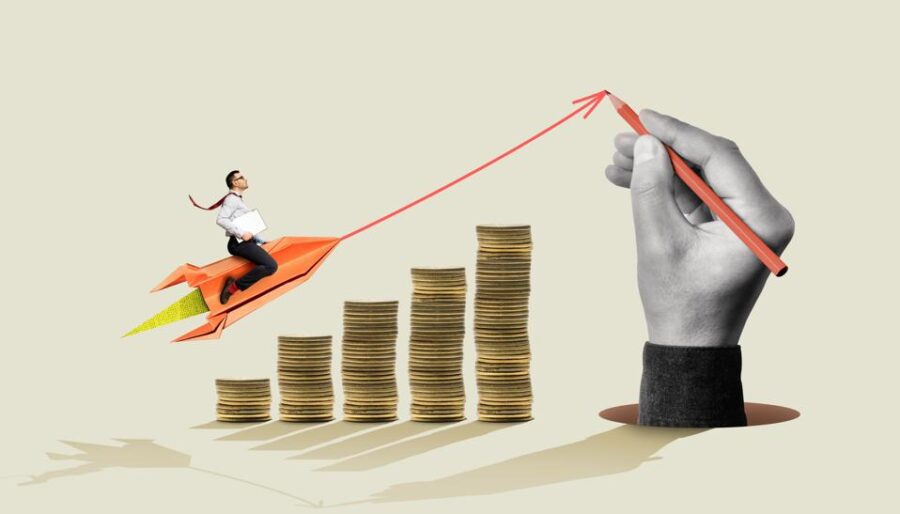The pronouncement by Larry Fink, CEO of BlackRock, that contemporary art stands as one of the “two greatest stores of wealth internationally today” sent ripples far beyond traditional collection circles, underscoring a significant shift in perception. In an economic climate characterized by persistent inflation and geopolitical instability, the allure of alternative investments has intensified, and art, with its unique blend of cultural resonance and financial potential, is increasingly scrutinized as a viable asset class. This evolving landscape is further evidenced by the Deloitte Art & Finance Report 2024, which revealed that for the first time in over a decade, financial value is a primary acquisition driver for 41% of collectors. This growing financial focus suggests a potential recalibration of market dynamics, influencing not only what is collected but how its ultimate value is determined and perceived.
The Canvas and the Ledger: Tracing Art’s Journey as an Asset
The intertwining of art and asset is not a novel phenomenon, though its modern interpretation has distinct characteristics. Historically, the accumulation of artworks often signified power, wealth, and cultural sophistication. The patronage of families like the Medici during the Renaissance, for instance, was instrumental in fostering artistic production while simultaneously cementing their own status and influence, laying an early foundation for art’s association with significant value. Later, the 18th-century Grand Tour further entrenched art acquisition as a hallmark of elite cultural capital, as wealthy Europeans journeyed to absorb and acquire pieces that would adorn their estates and signify their refined tastes.
A more formalized marketplace, crucial for art’s consideration as a tradable asset, began to emerge with the establishment of major auction houses. Sotheby’s, founded in London in 1744, and Christie’s, established in 1766, provided increasingly structured and public venues for art transactions. These institutions were pivotal in standardizing sales practices and enhancing price transparency, thereby facilitating the conceptual leap towards viewing art through an investment lens.
The 20th century witnessed more explicit attempts to treat art systematically as an investment. A notable early example was Andre Level’s “La Peau de l’Ours” syndicate in Paris in 1904. This group pooled resources to purchase works by then-contemporary artists, many of whom are now revered Impressionists and Post-Impressionists, with the clear intention of selling the collection for a profit, which they successfully did a decade later. A more substantial institutional foray occurred in 1974 when the British Rail Pension Fund allocated approximately £40 million to acquire a diversified art portfolio, marking a large-scale, systematic endeavor to utilize art as an investment vehicle.
The capacity to measure and track the performance of art as an asset class was significantly enhanced by the development of art market indices. The Mei Moses Fine Art Index, now the Sotheby’s Mei Moses Indices, pioneered a methodology based on repeat sales of the same artwork at auction to analyze price changes over time, controlling for subjective quality variations. Data from these indices, such as the reported 8.5% compound annual growth rate for the broader art market between 1950 and 2021, offers a quantitative framework for assessing art’s financial performance, crucial for attracting financially-minded collectors and comparing art to other investment classes. This historical progression, from status symbol to a market with dedicated infrastructure and analytical tools, illustrates the gradual but definitive financialization of art.
Navigating the Palette of Modern Art Investment: Trends, Players, and Valuations
The contemporary art market presents a complex and evolving picture for those considering it as an asset. Global art sales saw a period of adjustment, with estimates reaching $65 billion in 2023, a 4% decrease from 2022, and a further decline to $57.5 billion in 2024, down 12% from the previous year, signaling a cooling from the fervent activity of the post-pandemic recovery. However, this headline contraction masks a nuanced reality. A significant trend is market bifurcation: while sales of high-value works (over $10 million) dropped sharply, by 39% in 2024, the overall volume of transactions actually increased, by 4% in 2023 and 3% in 2024. This growth in volume was largely propelled by activity at lower price points, with sales of works under $5,000, for example, growing by 7% in value in 2024. Artmarket.com reported a historic record of 804,350 lots sold in 2024, an increase of 5%, even as global auction turnover fell by 33.5% to $9.9 billion. This suggests a broadening of the market base or a shift in collector strategy towards more accessible segments.
Regionally, the United States maintained its position as the largest market, commanding 42–43% of global sales by value, despite experiencing its own decline in sales figures. In 2024, the United Kingdom reclaimed the second position, while China, after a brief surge in 2023, fell to third place with a notable 31% contraction in sales. The online art market continues its ascent, reaching $11.8 billion in 2023, constituting 18% of the total market, with dealers’ own websites becoming preferred purchasing venues.
Comparative Asset Performance Snapshot
| Asset Class | Avg. Annual Return (Long-Term Est.) | Recent Performance (2023–2024 Highlights) | Volatility | Correlation to Equities | Key Characteristics |
|---|---|---|---|---|---|
| Fine Art | 8.5% (Broader Market, 1950–2021); Contemporary Art: 11.4% (1995–2024) | Market contraction in value, growth in volume at lower end; high-end softening | Higher than stocks | Low (e.g., -3% with S&P 500) | Tangible, illiquid, subjective value, diversification potential, passion investment |
| Stocks (S&P 500) | ~10.0% (1995–2024) | Strong returns in 2024 (+23%), though market concentration concerns persist | Moderate to High | 1 (Benchmark) | Represents corporate ownership, dividend income potential, liquid |
| Real Estate | US Real Estate: 3.9% (1995–2024) | REITs sensitive to interest rates (8.2% decline Q4 2024) | Moderate | Varies; REITs can show higher correlation | Tangible, potential for rental income, illiquid, high transaction costs |
| Gold | 7–10% (since 1971) | Strong performance in 2024 (+25% YTD), driven by safe-haven demand. Art outperformed gold over last decade (Artprice100 +87% vs Gold +24% since 2014) | Moderate | Near zero | Tangible store of value, inflation hedge, crisis hedge, no counterparty risk |
The art market’s structure is shaped by several key players. Dominant auction houses like Christie’s and Sotheby’s still orchestrate a majority of high-value public sales. Their leadership often comments on emerging trends such as digital art and the expansion into luxury collectibles, reflecting the market’s dynamism. Galleries range from global powerhouses like Gagosian, which significantly influence artist careers and market pricing, to smaller operations that demonstrated notable resilience in the recent downturn. The digital transformation is propelled by online platforms such as Artsy, Saatchi Art, and fractional ownership specialists like Masterworks, which are democratizing access and broadening the collector base. The collector landscape itself is evolving, with High-Net-Worth Individuals (HNWIs) remaining crucial, alongside an increasing presence of younger collectors (Millennials and Gen Z) who often exhibit different purchasing behaviors and preferences for contemporary and digitally-native art. The impact of significant private collections, such as those assembled by Eli Broad or Stefan Edlis, continues to shape museum holdings and public perception of art’s enduring value.
This divergence between a cooling high-end market and burgeoning activity at lower price tiers is more than a cyclical adjustment; it points towards a potential structural evolution. Economic uncertainties and rising interest rates may temper enthusiasm for multi-million dollar acquisitions, while the concurrent rise of accessible online platforms and innovative investment models like fractional ownership lowers entry barriers for a new cohort of enthusiasts and investors. This dynamic is particularly appealing to younger, digitally-savvy collectors who may have less capital but a strong interest in engaging with the art world. While art can offer competitive capital growth and valuable portfolio diversification due to its low correlation with traditional financial markets, its inherent characteristics, illiquidity, substantial transaction and holding costs, and the inescapable subjectivity of valuation, present a unique risk/reward calculus. For many, the “passion” derived from owning art justifies these complexities; for purely financially-motivated investors, the picture demands more careful consideration.
Beyond the Gilt Frame: Debating the Price and Value of Art
The increasing prominence of art as a financial asset has ignited a fervent debate about its fundamental value. A central critique of art’s financialization is that it risks undermining the intrinsic cultural, aesthetic, and social significance of artworks. When an artwork’s primary identity shifts towards that of an “abstract vehicle for liquidity,” as some scholars describe, its price history, auction performance, and artist “brand” can overshadow its artistic merit or historical importance. This transformation potentially redefines value in the art world, favoring quantifiable metrics and potentially marginalizing works that are culturally profound but less marketable. Legal scholar Stephen Guest has argued that art’s value has long defied conventional property norms, being rooted in something more intrinsic, even sacred, a quality strained by its absorption into purely financial systems.
This financial focus brings a host of ethical considerations to the fore. The art market has often been characterized by its opacity, sometimes described as one of the largest unregulated markets globally. This lack of transparency can foster an environment where pricing is unclear and “networks of undue influence” can thrive, potentially distorting market values. Conflicts of interest are another persistent concern, with instances of dealers or advisors promoting works in which they have an undisclosed financial stake, or auction houses employing complex mechanisms like secret reserves and third-party guarantees that can obscure true market dynamics. The specter of forgery and issues with provenance also loom large, with high-profile cases like the Knoedler Gallery scandal serving as stark reminders of how fakes can erode trust and decimate financial value. Such issues directly impact artists, who may face undue pressure, see their legitimate works devalued by forgeries, or find their creative output judged more by marketability than merit.
The motivations of collectors themselves reflect this complex interplay. While the Deloitte report highlighted that 41% now cite financial value as a primary incentive, a significant 60% still prioritize emotional appeal. Collector Claus Busch Risvig candidly admitted to considering resale value even when acquiring pieces out of passion, illustrating this dual consciousness. The immense collection amassed by figures like Stefan Edlis, driven by a visionary eye, ultimately translated into a financial asset valued at hundreds of millions.
Even public institutions are not immune to these pressures. Museums, traditionally custodians of cultural heritage, increasingly face expectations to adopt business-like strategies. This can lead to difficult decisions regarding the deaccessioning of works or, more controversially, the potential use of collections as collateral, thereby blurring the lines between their non-profit mission and commercial imperatives. The risk is that the traditional hierarchy, where cultural and aesthetic values were paramount, could be inverted, with financial metrics becoming the dominant lens for assessment. This is not to say that ethical lapses are merely isolated incidents; the art market’s historical lack of stringent regulation and reliance on private information have, arguably, created structural conditions where opacity and conflicts of interest could flourish. While there’s a contemporary push towards greater transparency, particularly through online platforms, the high-end market often continues to operate with a significant degree of discretion. If these ethical challenges and the fundamental debate over value are not thoughtfully addressed, the long-term credibility of art as a trusted asset class could be compromised.
The Future Canvas: Projecting Art’s Trajectory in the Investment World
The horizon for art as an asset class is being dramatically reshaped by technological innovation and evolving market dynamics. Fractional ownership is gaining considerable traction, particularly among younger collectors, with platforms like Masterworks enabling shared ownership of high-value artworks, thereby democratizing access and potentially enhancing liquidity. Blockchain technology and tokenization offer further transformative potential, promising secure and immutable records of provenance and authentication, which could reduce fraud and bolster investor confidence, while also facilitating the creation of tradable digital shares of physical artworks. Artificial intelligence is emerging as a dual force: AI-driven valuation models aim to bring more data-backed objectivity to pricing, while AI-generated art itself is becoming a new, albeit debated, collectible category, with some pieces already achieving significant prices at auction.
These technological advancements are occurring alongside a broader market evolution. The online art market is projected for robust growth, with forecasts suggesting it could reach between $15.9 billion and $17.76 billion by 2030, fueled by enhanced accessibility and the engagement of new collector demographics, especially Millennials and Gen Z. This trend is complemented by the sustained growth in transactions for artworks at more accessible price points (e.g., under $10,000 or $50,000), indicating a broadening of the market base. Furthermore, there is a discernible shift in collector and institutional interest towards non-Western art, promising a more geographically diverse and culturally representative market in the future.
In an era marked by geopolitical uncertainty and inflationary pressures, art’s traditional role as a store of value, often likened to gold, may be further amplified by these new technologies that enhance transparency and accessibility. However, this increasing financialization and the controversies of the past may also lead to greater calls for regulatory oversight. Technology, while offering solutions for democratization and transparency, introduces its own set of complexities, such as the valuation of purely digital or AI-generated works, the long-term security of digital assets, and the practical scalability of fractional ownership liquidity. The journey of art towards becoming a more defined and measurable asset class mirrors that of other alternative investments, a path that typically involves increased scrutiny, standardization, and potentially, regulation, as more capital flows in and novel financial products emerge.
Conclusion: The Enduring Enigma of Art’s Value
Revisiting Larry Fink’s assertion, it is clear that contemporary art has firmly established itself in the discourse of significant financial assets, yet it retains its profound identity as a cultural touchstone. For those looking to build a collection of art with an investment horizon, the journey requires a sophisticated understanding that balances the allure of potential financial returns against the realities of illiquidity, the inescapable subjectivity of value, and a complex ethical terrain. The aesthetic delight of a masterpiece and the cold logic of a balance sheet are now more intricately intertwined than ever.
The dialogue surrounding art as an asset is dynamic and far from resolved. As the market continues to evolve, shaped by technological advancements, shifting demographics, and new economic realities, the very definition of value in the art world will undoubtedly continue to be debated, challenged, and ultimately reshaped. Despite all attempts at financial modeling and quantification, the fundamental subjectivity inherent in art’s value will likely remain its most defining, and most challenging, characteristic as an asset. Unlike equities tied to corporate earnings or commodities like gold with more standardized metrics, art’s worth is deeply interwoven with taste, cultural narratives, and individual perception. This inherent subjectivity is both its enduring allure and its persistent risk, ensuring the art market remains a field where expertise, connoisseurship, and perhaps a measure of serendipity will continue to play compelling roles.









